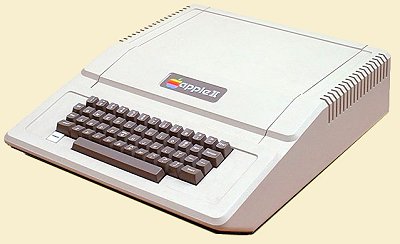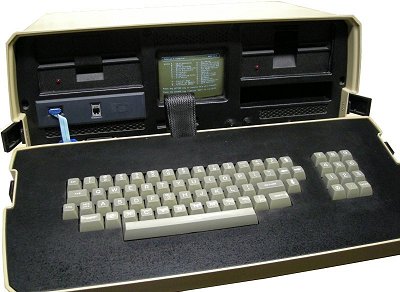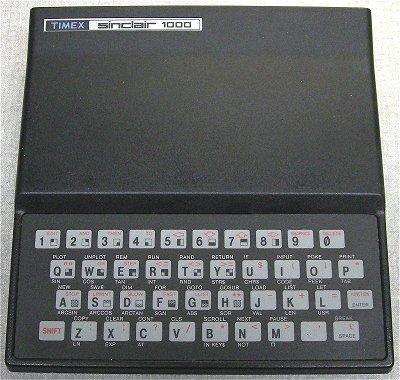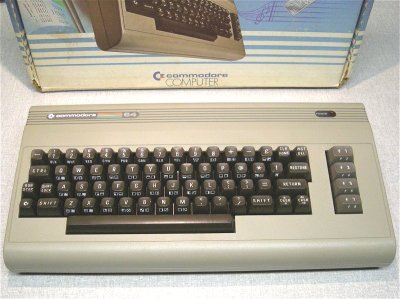Computers began appearing in the home in the mid to late 1970s. Most of these first personal computers were kits assembled by hobbyists and engineers wanting a computer to do programming work at home (see last month’s article). In the late 1970s, pre-assembled computers that could be purchased over the counter began to appear. By the 1980s, the home computer industry was in full swing and many of the computers marketed for home and small-business use included a number of productivity programs including spreadsheets and word processing.
In spite of millions of these early personal computers being manufactured, and even though they are not considered old enough to be antiques yet, several examples of these first home computers have become popular collectors items.

The Apple II, released in 1977.
In mid 1977 the Apple II computer was released. Prices started around $1,300 with a minimum amount of memory. The Apple II was considered to be the first home computer that was user friendly and easily expandable. Although the II was not a kit, its main board was also available to hobbyists separately.
The Apple II was a color computer that ran basic programming and could use a cassette drive for storage. Expansion cards were available that would allow the II to run floppy drives, emulate the popular CP/M operating system, expand memory, and add a SCSI interface. Expansion cards could be easily installed by removing the top cover.
Apple focused its efforts on software for business and education. Its VisiCalc spreadsheet program, released in 1979, was a major attraction to both home and business users. Apple II series computers remained in production until the early 1990s.
Although a computer mouse similar to what we are familiar with today was first used in the 1960s, it was not used on the Apple II and did not have widespread success until it was combined with the graphical user interface (GUI), which appeared on the next series of Apple computers in the 1990s.
The II was a huge success for Apple. It ensured Apple's future as one of the leaders in the home computer and small-business market. Today a good working original Apple II computer will most likely set you back a few hundred dollars.

The Osborne I portable computer with the optional modem.
The Osborne Computer Corporation released what is considered by many to be the first portable computer. The Osborne I went on the market in 1981. The keyboard doubled as the bottom of the cabinet and its handle made it possible to carry with one arm. There were other computers released previously that were labeled as portables, but it usually took two arms or two people to move them any distance. The Osborne could actually be considered a piece of carry-on luggage when traveling.
The Osborne I did have a few drawbacks. Its biggest drawback was the screen size. Its built-in display was less than four inches wide, requiring the use of keys to scroll left and right to view long lines of text or code.
On the plus side, the Osborne used a Z80 microprocessor and ran the CP/M operating system. It also had two built-in floppy drives, a place to store disks, and an optional modem. Besides the operating system included in the $1,795 cost, the Osborne came with a fairly large bundle of productivity software. The package software package included the SuperCalc spreadsheet program and WordStar word processing software. Osborne followed the I in 1982 with the Executive OCC-2 and later the Osborne Vixen.
Unfortunately, even though Osborne I sales rose quickly its first year, due to marketing blunders and a move by the industry to the IBM PC, the Osborne Computer Company was out of business before 1984. Today, you may still find a working Osborne I for under $200. The Executive OCC-2 might be found for slightly less. The Vixen, however, is very hard to find, and the early version of it with the black case would probably be the talk of many vintage computer forums if one turned up for sale.

Non Linear Systems Kaypro II computer.
In 1982 Non-Linear Systems (NLS) produced the popular Kaypro II portable computer. Until then Non-Linear Systems manufactured digital meters. In fact, Non-Linear Systems is credited with manufacturing the first digital meter in the 1950s.
The Kaypro II ran on a Z80 microprocessor and the CP/M operating system. It had a larger 9 inch screen with two 5¼ inch floppy drives. It was housed in a sturdy metal case with a carrying handle and like the Osborne I portable, the keyboard doubled as the cover. The Kaypro II cost $1,795 and also came bundled with a large selection of software including CP/M and word-processing and a spreadsheet programs.
In 1983, the Kaypro computer division split from NLS and Kaypro Computers was formed. It's interesting to note that the Kaypro II was the first Kaypro model and the Kaypro 1 was the last model produced by Kaypro almost 10 years later. Kaypro's insistence on staying with the CP/M operating system and waiting too long to move to the DOS operating system and re-releasing reconfigurations of old models were major factors in the company’s demise.
Today Kaypro IIs may be readily found on auction sites. Even though many have survived, most are missing the CP/M disks they need to operate along with the original applications disks. A working Kaypro II can usually be found for under $150 if you are patient. If it still has its complete original set of disks, expect the price to at least double.

The Timex Sinclair 1000 sold for under $100.
With the release of the Timex Sinclair in 1982, the cost of a home computer dropped to under $100. The Timex Sinclair 1000 was a renaming of the Sinclair ZX-81. The low price point was responsible for introducing many families to home computing that would never have spent well over $1,000 on a first home computer. The 1000 was small and contained only four integrated circuits. It sported a membrane keyboard, which was probably one of its weak points. Although hard to use, the small size and low initial cost made the Timex Sinclair very popular. Many companies sprang up offering accessories, games, and keyboard upgrades. Today, so many have survived that they have little to no value in collectors’ circles. I was able to pick up several 1000s and a ZX-81 along with software, games, and extra RAM packs at a swap meet recently for $20.

The popular Commodore 64.
The Commodore 64 is considered the most popular computer of all time. It was a remarketed version of Commodore's VIC-20. During the Commodore 64's lifespan, Commodore sold over 17 million units along with a wide range of peripherals, games, and software giving Commodore some of the highest home computer sales figures of the 1980s.
Running a MOS 6510 1-MHz CPU, the C64 was capable of high-resolution color graphics and sound. This made it excellent for gaming. Storage was accomplished using an external Commodore “Datasette” recorder, and later external floppy-disk drives. Due to so many units being produced, a working Commodore 64 today usually sells for between $60 and $125, depending on condition and what accessories are included.
I've noticed the number of vintage computer collectors has increased in recent years. Since some of these early home computers were similar to the early video game consoles of the same era, they are also becoming popular with many early video game collectors. As time passes, I expect to see many of these prices increase along with the popularity of collecting early home computers and video game consoles.
For more information and examples of early electronic technology, view my collection at StevesAntiqueTechnology.com
Advertisement
Learn more about Electronic Products Magazine





